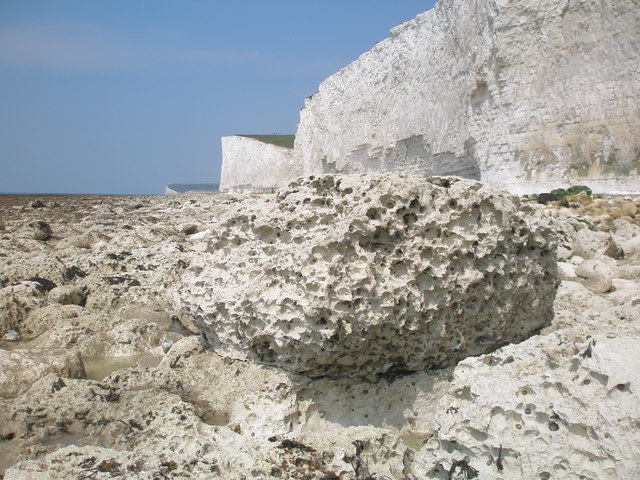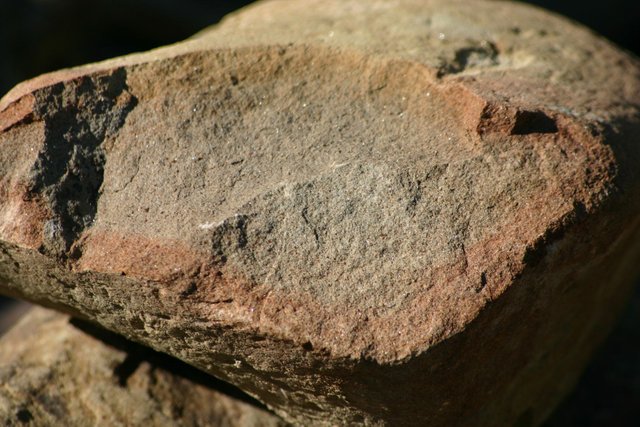Weathering (Mechanical and Chemical)
There are many ways in which rocks weather. They sometimes break up into blocks and further into smaller fragments, without their mineral components being changed. We call this process physical or mechanical weathering. On the other hand, the weathering may involve chemical changes in the mineral components, making the rocks decay. When this is the case, it is referred to as chemical weathering. We can distinguish various forms of these two major types of weathering.

Credit
Mechanical Weathering
In hot dry lands, changes in temperature from being scorchingly hot during the day to being freezingly cold at night cause rocks to expand and contract. This action makes the rocks break up or disintegrate into blocks. The pieces fall down to the base of the rock outcrop as big boulders, which may further break into smaller rock pieces called screes or talus. Since the rocks break in blocks, the process is referred to as block disintegration.
If granite rocks are subjected to temperature changes, the heating and cooling, and therefore the expansion and contraction, are restricted to a few centimetres or so from the surface of the rocks. So, instead of breaking up in blocks, the granite rocks peel off like layers of onions. This process is called exfoliation. The granite domes that are left standing are known as inselbergs.
In cold regions, particularly on high mountains, cracks occur in the rocks. The cracks get filled up with rain water during rain. In winter, temperatures fall below 0°C, and the water freezes. When water freezes, it increases in volume. So, the frozen ice wedges apart and cracks the rocks further. Pieces of the rock may fall off as screes. This type of physical weathering is referred to as frost shattering, but it is also a type of *block disintegration.
Alternate wetting and drying causes the rocks to absorb water and swell in the wet season, while they dry up and shrink in the dry season. This process cracks the ground surface if it is made up clay or mud. The resulting feature is called a mud crack. The crack may occur only a little area, but there are places where mud cracks extend to several square kilometres.
Another way in which rocks may weather mechanically is through the action of roots of plants. This is seen in particularly on steep hill slopes with rock outcrops. The roots of these plants anchor themselves in the rocks by piercing through the cracks in them. As the roots grow, they wedge the rocks apart and break off pieces of them.
Chemical weathering
Water itself and the hydrogen, oxygen and carbon dioxide dissolved in it are the most potent factors which cause chemical weathering. On absorbing any of these elements, a rock may either swell in volume, or simply decay, or the minerals in the rock may dissolve and be leached away, thus leaving the rock chemically weathered.
Depending on the type of rock, and the elements the minerals in it absorb and react to, four types of chemical weathering may result, and in the following ways:
If the rocks absorbs ordinary water, it reacts to it by swelling in volume. It then loosens up. This process of chemical weathering is called hydration. Other agents of erosion may then wash the hydrated rocks away.
However, if a rock containing certain minerals that easily react with the hydrogen absorbs water, the minerals react with the hydrogen in the water and turn into different minerals which may then change the original nature of the rock. This process is called hydrolysis.
When rocks containing iron (Fe) absorb water(H2O) which also contains oxygen , the iron reacts with the oxygen in the water and changes into iron oxide. The former rocks are then weathered into new types of rocks which now contain iron oxide in them. This process is known as oxidation. Thus under wet tropical conditions, ferruginous rocks (containing iron) weather into laterite and duricrust (containing iron oxide).

Credit
Sometimes, however, rain water (H2O) washes down carbon dioxide (CO2) from the air as it falls. The two combine to form a weak solution of carbonic acid (H2CO3). When this rain water (now weak acid) falls on rocks containing calcium carbonate (CaCO3) (e.g. limestone), the rocks absorb it. The calcium carbonate in the rocks reacts with the carbonic acid in the weak solution and forms calcium bicarbonate Ca(HCO3)2. In chemical language, this reaction is represented by the formula:
H2O + CO2 + CaCO3 = Ca (HCO3)2
This reaction simply decays the rocks ready to be washed away in solution. This chemical weathering process is called carbonation. Most limestone features are formed as a result of carbonation.
Hydration, hydrolysis, oxidation and carbonation are therefore four principal ways in which rocks can be chemically weathered. The deep chemically weathered. The deep chemically weathered portion of the rock on top of the earth is called the weathered profile.
Factors which determine weathering
In my discussion so far, it can be seen that in all the processes, there are three main factors which determine the type of weathering a rock may be subjected to, and the rate at which it weathers. These factors are:
The type of rock itself. Granite yields to exfoliation, while rocks with different minerals are differentlyweathered chemically as described.
The nature of relief. Steep slopes are prone to frost shattering (in cold weather), exfoliation (in hot weather), block disintegration. While in flat lands where clay and mud is exposed to alternating wetting and drying, mud cracks may result.
The climate. Cold climates are more conducive to frost shattering, while arid climates promote desert block disintegration and exfoliation. Hot wet climates promote rock decay by oxidation and carbonation faster than cold ones.
Reference
http://www.physicalgeography.net/fundamentals/10r.html
Pedology lecture notes

You received a 80.0% upvote since you are a member of geopolis and wrote in the category of "geography".
To read more about us and what we do, click here.
https://steemit.com/geopolis/@geopolis/geopolis-the-community-for-global-sciences-update-4
Great post donfelix, I really enjoyed it. I’ve been reading about weathering processes for years, but you can always learn something new from another persons point of view.
Fun Fact:
Stalactite and stalagmite caverns form when carbonates dissolve near the surface and precipitate deeper in the crust, Due to the process of carbonation. CaCO3 is retrograde or inverse soluble, meaning that It deposits out of solution with increased temperature.
Thanks for the fun fact
Very interesting post! It reminds me of my days in college, specifically in my Mechanical Engineering class where we had to learn about chemical process and molecules changes due to factors such as temperature =)
Wow, who would have imagine that through steemit, reading your post I was going to learn more about it, but specially thinking about these memories of my college life.
I found your post in the Daily Field Notes #58 + Photo contest! hosted by @geopolis
Congrats!